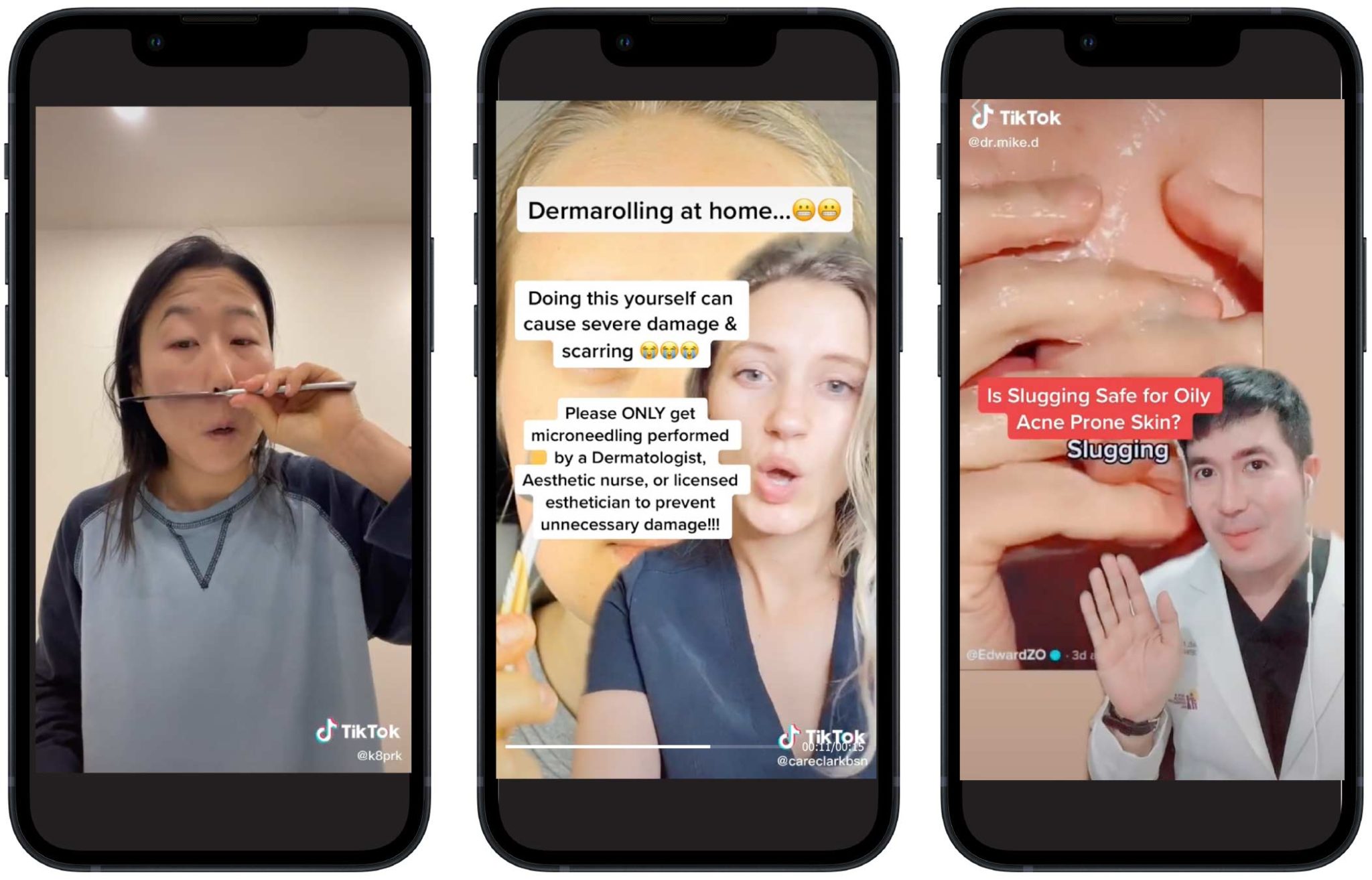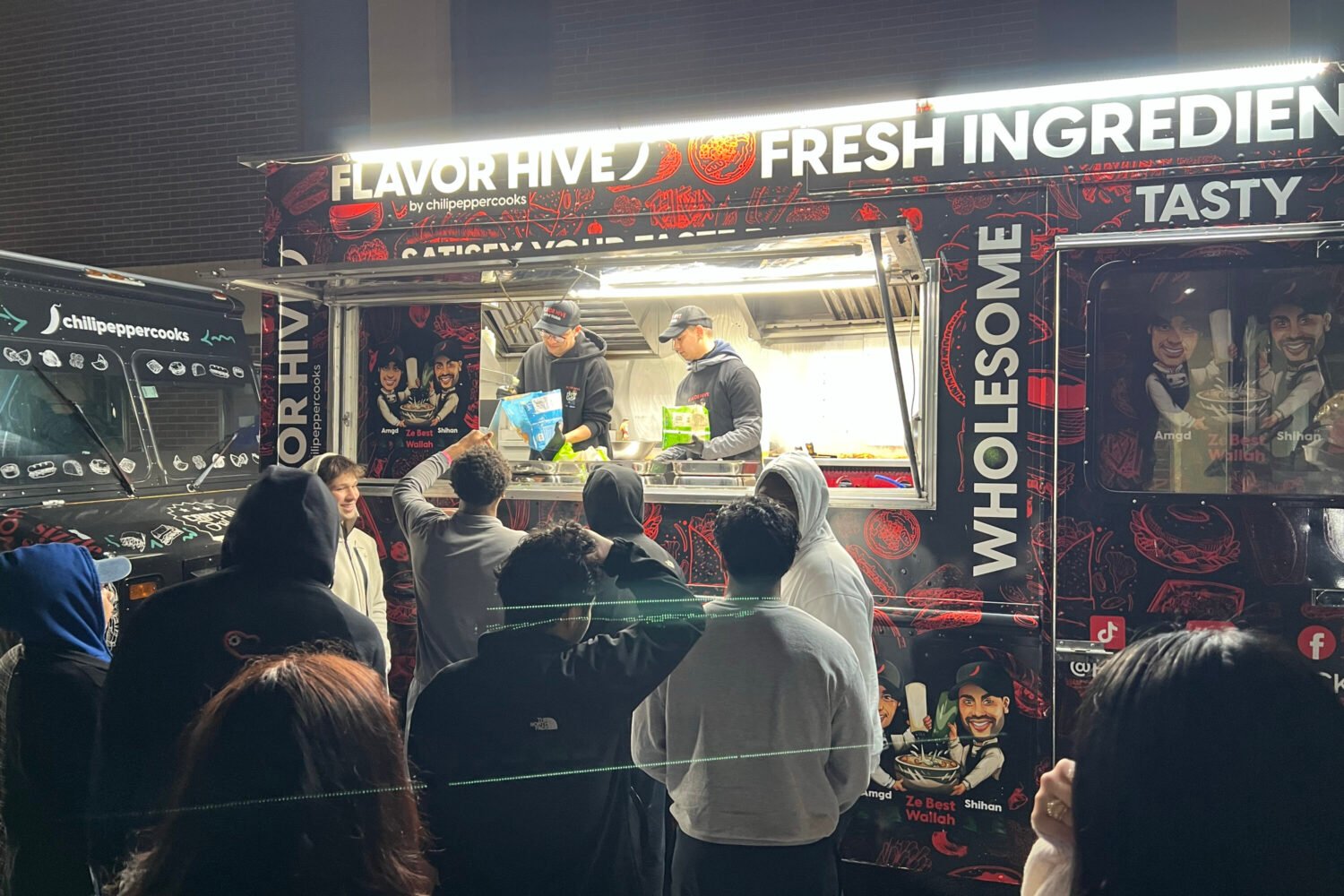You could lose days of your life to skin-care TikTok. Scratch that—years of your life. The #skincare TikTok tag has more than 79 billion views, and to scroll through the endless videos is a bit like whooshing past city apartment windows while on a train. Peer into one and you’ll see someone outlining all the products from her nightly skin routine. In another, an enthusiast might walk you through a new antiaging microcurrent device.
While beauty trends and hacks are by no means a new thing—see: medieval women removing their eyelashes and eyebrows or Victorian ladies using arsenic as face cream—the speed at which they now spread is unparalleled. Part of this is thanks to TikTok. Its short video format and algorithm are tailored to users’ interests and designed for rapid consumption and virality. “People definitely will come in and ask about something that’s gone viral on TikTok faster than something that might have a few years ago on Instagram,” says Anita Kulkarni, a DC plastic surgeon.
Many of these beauty trends are generally harmless, such as a new serum someone is influencing you to buy. (When acne-prone TikTokers started gushing about the Ordinary’s AHA 30% + BHA 2% Peeling Solution, the product saw a 426-percent jump in sales, according to Elle.)
But there are also DIY treatments on TikTok that can get dicey. One trend encouraged viewers to create freckles using sewing needles and ink—an Australian reality-TV star told the New York Times that her face got infected, she temporarily lost vision in one eye, and she had scarring after trying the hack. During Covid, doctors have taken public stances against TikTok trends such as sunscreen contouring (using SPF only on certain parts of your face when tanning to contour it) and at-home mole and freckle removal—the latter of which has seen people burning their skin.
Like I tell my patients, your face is not the place to save money.
“The issue is that a lot of people who don’t have the expertise to have a large following [do have one] and they’re giving wrong information,” says Ashburn plastic surgeon Maryam Nazemzadeh. She has seen a big influx in patients asking about TikTok cosmetic and skin-care techniques since the start of the pandemic, which she attributes to people having more time to scroll at home and being less inclined to go out for procedures.
“I always tell patients this stuff looks easy on TikTok because it’s trendy, it looks cool, there’s music in the background,” Nazemzadeh says. “But [a lot of this] is all medical-grade stuff. I mean, this is very serious stuff that requires sterile techniques [and] knowledge of anatomy.”
Kids, Don’t Do This at Home
DC plastic surgeon Michael Somenek has also seen an increase in patients asking about or trying TikTok trends, mostly women in their twenties and thirties. After watching an influencer do a step-by-step TikTok that outlined at-home chemical peels, one of these women ordered the chemicals off Amazon and burned a patch of skin on her cheek. In untrained hands, at-home peels can cause damage, says Somenek, and you may get the wrong acid type or concentration for your skin. Yet the #athomechemicalpeel tag has 1.4 million TikTok views.
Somenek says many of his patients who have tried or asked about at-home trends do so because DIY is cheaper than office procedures. But, as is the case with the woman who tried the peel, if something goes awry, you’ll likely end up spending more on fixing the results than on getting a professional procedure in the first place. “Like I tell every single one of my patients, your face is not the place to save money,” says Somenek. “It is something that you definitely need to devote money to and find the proper experienced providers to treat you. This is not something for you to be doing at home as a shortcut.”
Other DIY trends that should probably be left to the pros: microdermabrasion and microneedling. Microdermabrasion uses a minimally abrasive instrument to remove and exfoliate the outer layer of skin, and microneedling is the use of a small device with tiny needles to puncture skin and stimulate it to produce collagen. On the #microdermabrasion tag (216.1 million views) and #microneedling (395.8 million views), TikTokers show you tools to do this while you’re on the couch.
At-home microdermabrasion can lead to exfoliating your skin to the point of bleeding, says Somenek, and in some cases can result in lasting hyperpigmentation. Meanwhile, DIY microneedling could cause scarring if patients use a needle that penetrates the skin too deeply. Reusable microneedling rollers could also cause a bacterial skin infection such as cellulitis, says Somenek, as it’s unlikely you can sterilize the equipment appropriately at home. (The microneedling tools in his office are all single-use.)
Out of all the TikTok beauty trends she’s seen online, Kulkarni says the most dangerous is a hyaluron pen promoted as an at-home lip filler, about which both the FDA and the American Society for Dermatologic Surgery Association have issued warnings. The device uses pressure to push the filler hyaluronic acid into your skin needle-free. While none of the doctors interviewed for this article have had patients use these tools, all have had clients ask about the pens after seeing them on TikTok.
What’s the risk? The pens are not FDA-approved, and there’s also no guarantee you’re getting legitimate hyaluronic acid, say the physicians. And if you use one incorrectly to inject filler into your lips, says Somenek, you could occlude a blood vessel and cause skin necrosis—a complication in which skin cells die. Definitely not the cute TikTok trend you were going for.
Couldn’t Hurt to Try
Not all TikTok skin and beauty trends come with the threat of potential scarring. But just because something is relatively safe doesn’t mean it’s effective.
Take the recent internet phenomenon known as #slugging (206.9 million views). Acolytes of the K-beauty trend end their nighttime skin-care routines by smearing a layer of petrolatum-centric products such as Vaseline or CeraVe healing ointment over their faces to moisturize and seal in their products. Devotees of slugging swear by it to achieve glowing, hydrated skin. “Oh, my goodness—when I wake up on a slugging morning, my skin looks perfect,” says Hayley Alexander, a slugging advocate. (That’s not her full-time job—she works in government affairs.) “It’s just been a game-changer.”
The 32-year-old Alexandria resident downloaded TikTok at the beginning of the pandemic and spends about 45 minutes on it daily. Her “For You” page’s algorithm (or FYP, as it’s known) serves her up a blend of cleaning hacks, cat videos, how-to’s for curly hair, and skin-care tips—which is where she learned of slugging.
Despite what advocates say, can slathering a thick, gelatinous substance all over your face really be good for you? Eh—maybe, maybe not. Somenek doesn’t recommend it, as petrolatums don’t absorb into skin and can clog pores and cause blemishes. But while Nazemzadeh agrees regular use could lead to breakouts, she says slugging is fine to do occasionally when your skin is very dehydrated. She does recommend using a petrolatum under your eyes a few times a week to treat dry skin, fine lines, and wrinkles, as under-eye skin isn’t prone to breakouts.
Another tip spreading through skin and beauty TikTok: the use of gua sha tools for the face (892.8 million views). Gua sha is the practice of using lymphatic-draining massage and body scraping to promote circulation, reduce puffiness, and make skin firmer. On TikTok, you’ll see people running gua sha tools—such as small, angled stones made of rose quartz or jade—along their faces. (But don’t call it a trend; the gua sha practice has deep roots originating in Chinese medicine. Some have pointed out that social media’s recent obsession with gua sha is a form of cultural appropriation.)
Jessica Peña, a 39-year-old paralegal in College Park, bought a gua sha tool for her face a few years ago after she saw it on YouTube. But she didn’t use it regularly until last year when gua sha videos started popping up on her TikTok FYP. Now she does it three to four times a week. “I feel it more than I see it,” says Peña of the result. “It just makes me feel better. My face isn’t as puffy in the morning. It kind of almost feels a little plump.”
Can gua sha reduce inflammation? Sure. Will it provide you a Botox-like facelift? Not likely. Somenek thinks gua sha massage is a good way to reduce facial puffiness temporarily. But, he says, if you’re looking for noticeable, longer-term firming or antiaging effects, you’ll have to see a dermatologist or plastic surgeon.
Somenek’s sentiment is indicative of physicians’ overall opinions of TikTok’s beauty hacks: If you’re trying to get significant results, you’ll likely need to go to a doctor.
Not everyone, of course, is blindly trying TikTok trends: Alexander, for one, makes sure to follow licensed skin-care experts on TikTok, as many of them call out harmful practices and advise viewers against trying them. Meanwhile, Peña vets any hack she considers. “I don’t try any of these things unless I do my research,” she says, adding that she’ll run ideas by her dermatologist. “If I feel comfortable, then I’ll try [them].”
Given all the questionable advice and vetting you may have to do, is skin-care TikTok a worthy resource? Kulkarni thinks the negatives outweigh the positives. “You’re basically influencing a super-young population with data and information that has no vetting,” she says of TikTok’s audience, which veers more toward Gen Z than other platforms do. “In an instant, it will be everywhere, and people will see and maybe even try it before they have a chance to know that it’s not safe.”
Somenek and Nazemzadeh, meanwhile, both point out that having access to knowledge via TikTok is ultimately a good thing, as long as people continue to take social-media-gathered information with a grain of salt.
“[My] fear would be that it becomes socially acceptable to use this platform as a means of doctor TikTok, if you will. Like, ‘Oh, I saw this on TikTok, and the person said it was legit, so I did it,’ ” says Somenek. “ ‘And now, lo and behold, here’s my complication.’ ”
This article appears in the April 2022 issue of Washingtonian.




















